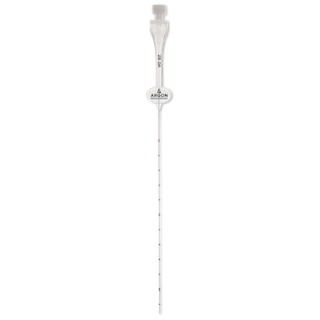Description
Argon Medical Devices 384115 - Argon First PICC Silicone Catheter, 20 G, 5/CS
Argon Medical Devices 384115 First PICC Silicone Catheter
Argon First PICC Catheters are high-quality silicone catheters designed for safe and easy placement while providing comfort to the patient.
| Catalog No. | Size | Length | Special Feature |
| 384115 | 20 G , 3 F | 65 cm | BD Introsyte AutoGuard Introducer |
Universal application
- Breadth of line offers access options for neonate to geriatric patient populations
Soft silicone integrated extension set
- Designed to enhance patient comfort and to provide increased mobility
Pre attached T-port extension
- Allows ushing of the catheter before, during and after insertion
Protective sleeve
- Designed to minimize accidental contamination of the catheter
Centimeter markings
- Designed to allow easy measurement and catheter trimming prior to insertion
Trimming tool
- Catheter trim tool is designed to ensure clean and accurate trimming and provides a 90 cut consistent with INS standards and FDA recommendation
Not made with natural rubber latex and DEHP free
Argon Medical Devices 384115 First PICC Silicone Catheter Insertion
Identify Appropriate Vein
Position and Measure Patient
- For PICC Placement Upper Extremity: Position the arm at a 90 angle, and measure from the planned insertion site to the right clavicular head, then down to the third palpated intercostal space for superior vena cava (SVC) placement.
- For PICC Placement Lower Extremity: Measure from planned insertion site to the right of the umbilicus and up to the xiphoid process for inferior vena cava (IVC) placement.
- For MIDLINE Placement: Measure from the planned insertion site to the appropriate tip position. NOTE: External measurement can never exactly duplicate the internal venous anatomy.
Setup Sterile Field
- Open package to expose the contents of the tray.
- Setup and prepare the necessary equipment using aseptic technique.
Prep Site and Drape Patient
- Prep the anticipated puncture site according to institutional policy.
- Drape patient.
Prime and Trim Catheter
- Attach syringe filled with sterile normal saline, and prime catheter
- Peel open catheters protective sleeve to the length measured in step 2.
- If present, withdraw the stylet one-half centimeter shorter than the length measured in step 2.
- If necessary, trim the distal end of the catheter squarely to the length measured in step 2.
Apply Tourniquet
Perform Venipuncture and Withdraw Introducer
- Use introducer per Instructions for Use enclosed with introducer
Advance Catheter
- Peel-away-cannula may be removed at any point in the insertion process based on clinician preference.
- Continue to advance the catheter slowly in small increments.
- For SVC: As the catheter tip passes the shoulder, have the patient turn head toward the insertion site with chin on shoulder to help prevent possible malposition into the jugular vein.
- Complete catheter advancement to the desired tip position.
Remove Stylet (if present)
- Extend the catheter tubing and extension in a straight line with the vein.
- While stabilizing the catheter by holding the oval junction or Y-site, grasp the stylet handle and withdraw gently and slowly. Catheter bunching indicates stylet resistance.
- Do not use the catheter tubing for stabilization during stylet removal.
- If resistance or bunching of the catheter is encountered, stop stylet withdrawal and allow the catheter to return to normal shape.
- Then withdraw both the catheter and stylet together about one inch, repeat priming with saline, and try removing the stylet again.
- Repeat this procedure until the stylet is easily removed.
- Once the stylet is out, advance the catheter into the desired position without the stylet.
Aspirate and Flush
- Use a 10 mL syring design to flush the catheter. Do not use force to flush the catheter as a 10 mL syringe design has the potential to generate high pressure (greater than 40 psi) capable of rupturing the catheter.
- Aspirate to visualize blood return and fluch to ensure patency of all lumens. Attach the accessories and flush per institutional policy.
- Remove Y-site or T-connector and replace with Luer lock extension set or injection cap
- Remove drape.
- Clean insertion site.
- Apply skin protectant if desired
- The external portion of the catheter must be adequately secured. Any change in the length of the external portion of the catheter at the insertion site indicates that the tip location has been altered as well.
- Dress according to institution policy and procedures.
Confirm catheter tip placement radiographically if indicated. Radiographic confirmation of tip placement is required for all central tip placements
Catheter Removal
- Remove dressing.
- Grasp catheter near insertion site.
- Remove slowly. NOTE: Do not use excessive force.
- If resistance is felt, stop removal. Apply warm compress and wait 20-30 minutes.
- Resume removal procedure.
Device Characteristics of Argon Medical Devices 384115 First PICC Silicone Catheter
| What MRI safety information does the labeling contain? | Labeling does not contain MRI Safety Information |
| Device required to be labeled as containing natural rubber latex or dry natural rubber (21 CFR 801.437): | No |
| Device labeled as "Not made with natural rubber latex": | Yes |
| For Single-Use: | Yes |
| Prescription Use (Rx): | Yes |
| Over the Counter (OTC): | No |
| Kit: | No |
| Combination Product: | No |
| Human Cell, Tissue or Cellular or Tissue-Based Product (HCT/P): | No |
